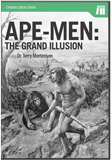Relative of Ape-Woman Lucy?
He’s the new “big man” of human evolution: Kadanuumuu, a purported relative of famous ape-woman Lucy.
News Source
- National Geographic News: “‘Lucy’ Kin Pushes Back Evolution of Upright Walking?”
The fossil hominid was found in 2005 in Ethiopia, and received its nickname thanks to its height: between 5 and 5.5 feet (1.5–1.8 m). That’s relatively tall compared to Lucy, believed to be an ancestor of Kadanuumuu, who stood around 3.5 feet (1.1 m). According to the scientists describing the fossil in the journal Proceedings of the National Academy of Sciences, Kadanuumuu is an Australopithecus afarensis, like Lucy; however, the “big man” is dated older than Lucy, at 3.6 million years. (The find has also been nicknamed “Lucy’s great-grandfather.”)
But there’s a twist: Kadanuumuu’s skeletal features are unexpectedly similar to those of modern humans, according to Cleveland Museum of Natural History curator of physical anthropology Yohannes Haile-Selassie. “We can now confidently say that ‘Lucy’ and her relatives were almost as proficient as we are walking on two legs,” said Haile-Selassie. “The elongation of our legs came earlier in our evolution than previously thought.”
Kadanuumuu’s skeletal features are unexpectedly similar to those of modern humans.
Additionally, Kadanuumuu’s shoulder blade is not as ape-like as the scientists expected. “Most scientists presumed that our ancestors’ shoulders were more like those of chimpanzees,” explained Haile-Selassie. Instead, Kadanuumuu’s shoulder blades are quite different from modern apes’. Based on that, the scientists conclude that Kadanuumuu and Lucy were no better at swinging in trees as modern humans are. “Its anatomy wouldn’t allow it to be [primarily] a tree-climber, as claimed by some people,” noted Haile-Selassie; on the other hand, “[Kadanuumuu] could actually stand on one leg and keep its balance[,] something chimpanzees cannot do.”
Disagreeing with Haile-Selassie is California Academy of Sciences anthropologist Zeresenay Alemseged, who discovered the fossil nicknamed Selam considered a juvenile A. afarensis. (We reported on this discovery in September 2006.) He argues that the limited remains of Kadanuumuu mean scientists cannot be certain what species it is, and that differences with Lucy and Selam show Kadanuumuu to be something other than A. afarensis. (ScienceNOW reports that the find is only forty percent complete—and lacks a head.1)
The debate underscores one of the biggest problems with forming grand conclusions from fossil hominids: most of the fossils are woefully incomplete, with guesswork and presupposition-soaked interpretations filling in the gaps (a problem that ultimately obstructs both evolutionist and creationist study of the fossils). As a consequence, it’s no surprise that Lucy, Selam, and Kadanuumuu’s features may seem incompatible—they may not be the same species after all; indeed, it may be that, e.g., one is a true human while the others are not.
Given Kadanuumuu’s missing bones (especially his head) and the fact that most mainstream researchers—let alone creationists—have not yet studied the find up close, it’s difficult to draw any clear conclusions about whether Kadanuumuu was human or ape, or whether it was indeed a relative of Lucy or not. Based on Haile-Selassie’s endorsement of the similarity between Kadanuumuu and modern humans, along with creationists’ general skepticism over Lucy’s humanity, we are inclined to consider Kadanuumuu a human whose evolutionarily determined age and lack of head has him falsely lumped with what are almost certainly apes.
Further Reading
- Farewell to “Lucy”
- Lucy and Her “Child” Look Like Extinct Apes After All
- “Lucy” isn’t the “Missing Link!”
- Did Humans Really Evolve from Apelike Creatures?
- Get Answers: Ape-Man, Missing Links, Fossils
For More Information: Get Answers
Remember, if you see a news story that might merit some attention, let us know about it! (Note: if the story originates from the Associated Press, FOX News, MSNBC, the New York Times, or another major national media outlet, we will most likely have already heard about it.) And thanks to all of our readers who have submitted great news tips to us. If you didn’t catch all the latest News to Know, why not take a look to see what you’ve missed?
(Please note that links will take you directly to the source. Answers in Genesis is not responsible for content on the websites to which we refer. For more information, please see our Privacy Policy.)
Footnotes
- Ann Gibbons, “Oldest Skeleton of Lucy’s Species Revealed,” Science, June 22, 2010, http://www.sciencemag.org/news/2010/06/oldest-skeleton-lucys-species-unveiled.
Recommended Resources

Answers in Genesis is an apologetics ministry, dedicated to helping Christians defend their faith and proclaim the good news of Jesus Christ.
- Customer Service 800.778.3390
- © 2024 Answers in Genesis




